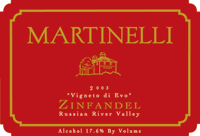 |
|
Wine Details
Price:
Description:
This tiny vineyard site is on Martinelli Road in Forestville, where the original family homestead ranch was founded in 1898 and where members of the family still live today. The planting of the vines date back to sometime around the turn-of-the-century. Evo Martinelli was the grandson of Giuseppe & Luisa Martinelli, whom emigrated from Italy and planted the Jackass Hill Zinfandel Vineyard. For five generations Martinelli children have lived and played together along Martinelli Road, scampering through the woods and swimming in the crik. First cousins Lee Martinelli, Sr. and Evo Martinelli were childhood friends and remained so into adulthood. Always having an interest in whatever happens to be growing on a grapevine, Lee, Sr. approached Evo one day and inquired as to what varietals were growing in the little patch of vineyard next to the hay barn. When Evo mentioned Zinfandel, Lee was very enthused and a deal was made. He soon began the caretaking and harvesting of the vines and Evo was thrilled that the grapes were going to a good home. We are fortunate to be able to include these old vines in making wine from one of Sonoma County's oldest Zinfandel vineyards. The “Vigneto di Evo” site lies directly below Jackass Hill, the grandfather of all Zin. The wine is reminiscent of my Noni's blackberry cobbler, covered in brown sugar with a dollop of sweet fresh cream.
|
|
Varietal Definition
Zinfandel:
Zinfandel is a variety of red grape planted in over 10 percent of California wine vineyards. DNA fingerprinting revealed that it is genetically equivalent to the Croatian grape Crljenak Kaštelanski, and also the Primitivo variety traditionally grown in the 'heel' of Italy. It is typically made into a robust red wine. Its taste depends on the ripeness of the grapes from which it is made. Red berry fruits like raspberry predominate in wines from cooler areas such as the Napa Valley, whereas blackberry, anise and pepper notes are more common in wines made in warmer areas such as Sonoma County. Many Zinfandels come from head pruned ‘Old Vines’. ‘Old Vine’ is generally understood to mean a vine that is more than 50 years old and that produces less than three tons per acre. ‘Head Pruning’ is an old European style of pruning that trains the vine into the shape of a goblet. It requires no wires or other complex trellis systems. Head pruning spreads the fruit uniformly along the vine and allows light penetration.In the USA a semi-sweet Rosé (blush-style) wine called ‘White Zinfandel’ has achieved widespread popularity. In fact, this popularity has so outstripped all other forms that many fans think there is actually a grape called “White Zinfandel” (there isn’t)!
|
|